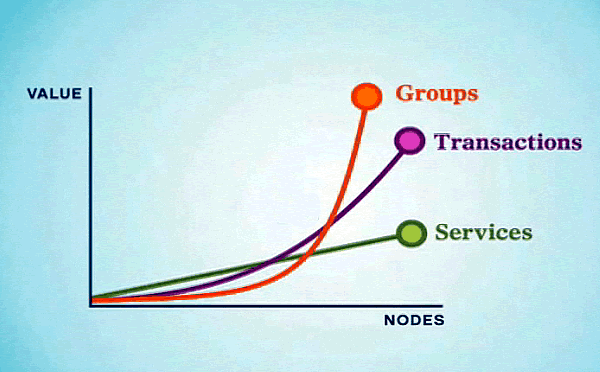The laws of networks (memo, roughly)
Sarnov's law : The usefulness of the network is proportional to the number of its elements. [Connect the elements to the network. Dial into the network as many items as possible.]
Metcalf's law : The utility of the network is approximately half the square of the number of users. [Give elements the opportunity of not simple, but two-way communication.]
Reed's law : The usefulness of a social network is exponentially dependent on the number of its members. [Let me create groups and communicate collectively, in groups.]

The genesis is approximately as follows.
At the first stage of the network development, the Sarnov law is in effect, the service providing communications, the connection itself, becomes most important. The opportunity to communicate is appreciated.
At the second stage the law of Metcalf acts, the most important is the content, the transmitted information. There is a struggle for the finished product. Individual units are valued.
At the third stage, the Reed law is in effect, the most important are not the products, but the means of production, that is, the opportunity to participate and organize something. Many appreciate.
That is, along with the growth of the network, its values also change.
')
Video: http://blip.tv/file/1823777
In addition, remember that the above laws only describe the process mathematically. They do not mean that if you create a network platform and overtake people there, the project is doomed to success. Of all the many potential links within the network, only those that are really interesting to the network elements will play a role.
To stimulate the life of the network, try using social objects . Social networks consist of people who are united not by the very possibility of being connected, but by social objects. Therefore, some sociologists do not speak about social networks, but about socio-material networks, actions, participation.
Metcalf's law : The utility of the network is approximately half the square of the number of users. [Give elements the opportunity of not simple, but two-way communication.]
Reed's law : The usefulness of a social network is exponentially dependent on the number of its members. [Let me create groups and communicate collectively, in groups.]

The genesis is approximately as follows.
At the first stage of the network development, the Sarnov law is in effect, the service providing communications, the connection itself, becomes most important. The opportunity to communicate is appreciated.
At the second stage the law of Metcalf acts, the most important is the content, the transmitted information. There is a struggle for the finished product. Individual units are valued.
At the third stage, the Reed law is in effect, the most important are not the products, but the means of production, that is, the opportunity to participate and organize something. Many appreciate.
That is, along with the growth of the network, its values also change.
')
Video: http://blip.tv/file/1823777
In addition, remember that the above laws only describe the process mathematically. They do not mean that if you create a network platform and overtake people there, the project is doomed to success. Of all the many potential links within the network, only those that are really interesting to the network elements will play a role.
To stimulate the life of the network, try using social objects . Social networks consist of people who are united not by the very possibility of being connected, but by social objects. Therefore, some sociologists do not speak about social networks, but about socio-material networks, actions, participation.
Source: https://habr.com/ru/post/61686/
All Articles